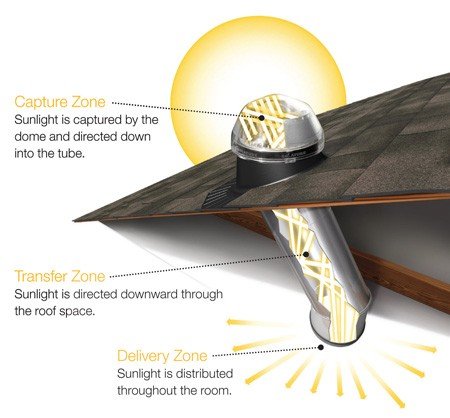Everyone knows and understands how a traditional skylight works. It’s basically a roof window — it just lets the light in through transparent glass. There’s no mystery. However, if you’ve seen Solatube tubular skylights in action, but haven’t seen them from the inside out or explored how they can be installed, they seem almost miraculous. Who would think that sunlight can be directed to areas in the interior of a building with such precision and high intensity! If you haven’t seen it for yourself, then take a look at some photos of existing installations in homes and commercial spaces.
Done? Good. Here’s how it works:
The Capture Zone
The capture zone incorporates Raybender® 3000 Technology and a Lighttracker™ Reflector. What does that mean?
The Raybender® 3000 Technology uses a series of lenses to capture more indirect light and less too-bright, too hot direct light. That means that the amount of light that’s captured stays fairly steady in cloudy or sunny weather, in summer, in winter, even in the morning, evening and midday. It is designed to bring in more light when it’s needed and less light during times when the light is uncomfortably bright. It brings in light while excluding most heat, so it won’t contribute greatly to solar gain. The Lighttracker™ Reflector takes the light that’s been absorbed into the skylight and directs it straight down the skylight tube, minimising the number of times it will reflect off the walls and preserving as much of its intensity as possible.
The Transfer Zone
Solatube skylight tubes are lined with the most highly reflective material available; Spectra Light Infinity. Every time the light bounces off the side of the tube, it retains 99.7% of its intensity and releases very little heat. However, that three tenths of a percent can add up. If the light bounces 100 times, it loses 30% of its intensity. That’s why there’s a limit to the length of the tubes and why it’s best to minimise the number of turns in the tubes. However, as you can imagine, light can travel quite some distance in these tubes before it loses a significant portion of its intensity. The extreme reflectivity of the transfer zone is another reason why these tubular skylights work so surprisingly well.
The Delivery Zone
After the light has been absorbed, directed down the tube and bounced along to its destination, it will reach the delivery zone. That’s where it’s released into the interior of your home or building, probably into a fixture that looks a lot like an electric ceiling light. This is where the light can be dimmed or blocked if it isn’t wanted and this is where it can be boosted with LEDs or CFLs when the daylight is too dim to provide full illumination. This is where you can install a stylish Solatube’s decorative skylight fixture.
Solatube skylights may not be as simple and straightforward as a standard skylight or roof window, but the performance speaks for itself. They’re full of simple and innovative solutions in both materials and basic mechanics. The ingenuity is in how these elements are gathered together to greatly reduce or even eliminate the need for electrical lighting in interior spaces. Whether you’re an Architect, an Engineer, a property owner or a tradesperson, you are going to want to keep these skylights in mind for your upcoming projects!



Hi,
My family and I are in the process of waiting for the appointment where we’ll go through the Tender doc leading to Final Building Contract, Colour selection and Electrical choices due on Thursday 02/09/2021. Our builder is JG King Homes (Steel Frame Homes), and our house will be built in our 2 Hectares vacant land lot in Trawalla, Vic 3373 (about 8 minutes from Beaufort).
We would like to know more information and prices ASAP, so that we can factor in the Solatube Skylight & LED system.
Kind regards,
The Belmar Family
Hi Roberto,
Bendigo Cedar Sales can assist with price estimates, but you may need to supply them additional info (room sizes, accessory options, tube lengths, roof type) for more accurate quotes. Here is a price guide to suit all budgets to give you an idea on pricing, this doesn’t include installation costs, Bendigo would be able to provide this. https://solatube.com.au/skylights/tubular-skylight-costs-comparison/ The builder can source product for you on a supply only, or supply and install basis… unless builder already has a Solatube supplier in Melbourne, which JG King Homes very well may have.
Our other advice would be to be specific with the builder on brands and model numbers in the tender documents, otherwise there are plenty of cheap and underperforming imitation tube skylight products out there. On the Bendigo Cedar page there is a product brochure which you could use as a product reference. https://solatube.com.au/dealer/bendigo-cedar-sales/